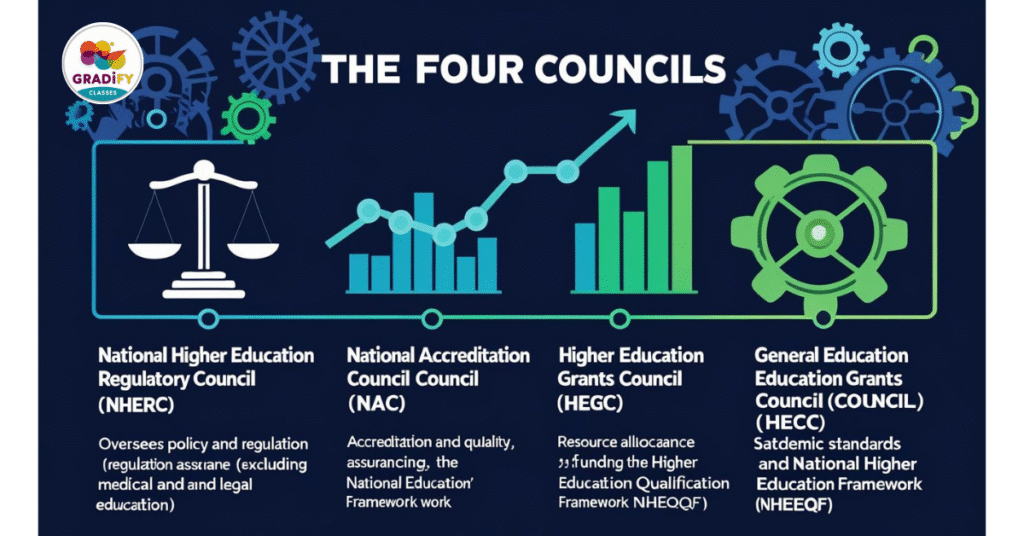Introduction
In July 2025,the Higher Education Commission of India HECI the Ministry of Education formally announced that it is drafting legislation to establish. This new body is set to replace the University Grants Commission (UGC), AICTE, and NCTE, marking a pivotal moment for India’s higher education regulatory framework . Guided by the vision of the National Education Policy 2020 (NEP 2020), HECI aims to usher in a regulatory system that is “light but tight” — transparent, resource-efficient, and innovation-friendly
Why a Unified Regulator? The Case Against UGC, AICTE & NCTE
Since their inception, UGC, AICTE, and NCTE have been instrumental in overseeing various aspects of higher education—non-technical degrees, technical institutions, and teacher education programs, respectively. However, experts have long criticized:
-
Overlapping jurisdictions cause confusion and unnecessary bureaucracy.
-
Inconsistent quality control, with standards varying across institutions.
-
Inefficient governance often delays reforms and stifles academic innovation
HECI is envisioned as a single umbrella body to resolve these inefficiencies and deliver more streamlined oversight.
Structure and Vision: Four Independent Verticals Under One Umbrella
NEP 2020 outlines a groundbreaking reform: HECI will function through four verticals, each specializing in a core domain of higher education
-
National Higher Education Regulatory Council (NHERC): Oversight and policy-making for regulation (excluding medical and legal education).
-
National Accreditation Council (NAC): Accreditation and quality assurance, consolidating functions akin to NAAC and NBA under one roof.
-
Higher Education Grants Council (HEGC): Resource allocation and funding—replacing UGC’s grant distribution system.
-
General Education Council (GEC): Academic standard setting, including curriculum frameworks and qualifications structure under a unified National Higher Education Qualification Framework (NHEQF).
This distinct division aims to establish checks and balances, prevent conflicts of interest, and enhance institutional autonomy
Historical Context: From Draft Bill 2018 to Revival in 2021
The idea of a unified regulator is not new. A draft bill titled Higher Education Commission of India (Repeal of University Grants Commission Act) Bill, 2018, was introduced for public consultation to repeal the UGC Act of 1956. However, momentum waned until July 2021, when Education Minister Dharmendra Pradhan revived the initiative as part of NEP 2020 implementation
Since then, the proposal has gained traction, and on July 21, 2025, Union Minister of State for Education Sukanta Majumdar confirmed HECI’s official drafting in a written reply to the Lok Sabha
Potential Benefits of HECI
A successful HECI would bring several advantages:
-
Streamlined Governance: Institutions will engage with one authoritative body rather than three separate regulators.
-
Reduced Bureaucracy: Administrative duplication is minimized, accelerating decision‑making and reform implementation.
-
Standardized Quality & Accreditation: Uniform accreditation criteria under NAC across academic streams.
-
Merit-Based Funding: HEGC’s transparent funding model ensures resources are allocated based on performance and institutional achievements.
Collectively, these reforms aim to energize India’s higher education sector, aligning it closer to global standards
Concerns & Challenges Ahead
Even while heralding reform, experts have raised possible risks:
-
Centralization of Power: Consolidating multiple agencies under HECI could lead to bureaucratic concentration and reduced dissenting voices.
-
Loss of Specialized Expertise: Niche agencies like NCTE and AICTE have domain knowledge that may be diluted under a single body.
-
Threat to Academic Autonomy: Institutions fear regulatory overreach may limit their freedom, especially in curricula and governance.
-
Implementation Bottlenecks: Transitioning to HECI requires careful planning, legal clarity, and capacity-building across bodies
Balancing central authority with institutional autonomy remains a critical challenge.

HECI in Context: NEP 2020’s Bigger Agenda
HECI forms a central pillar within the broader NEP 2020 mission to recalibrate India’s educational architecture. Other reforms include:
-
Allowing international universities to establish campuses in India, improving academic exchange/global parity.
-
Promoting multi-disciplinary programs, such as four‑year bachelor’s degrees with multiple exit options.
-
Launching initiatives like the Academic Bank of Credits, National Research Foundation, Gender Inclusion Fund, and infusion of Indian knowledge systems in curricula.
Collectively, HECI is expected to complement these measures by ensuring institutions meet new academic and administrative standards.
Looking Ahead: What to Expect From the Bill
While the HECI Bill remains in draft form, here’s what observers expect to follow:
-
Clear legal mandate for HECI and its verticals (NHERC, NAC, HEGC, GEC).
-
Transition plan for winding up UGC, AICTE, NCTE, and merging accreditation bodies like NAAC and NBA.
-
Institutional safeguards for academic independence and diversity.
-
Criteria-based funding mechanisms under HEGC.
-
Timeline for roll‑out, including stakeholder consultations—especially from state governments and educational institutions.
How Will Students & Institutions Benefit?
-
Simplified compliance: Single window regulation reduces confusion for universities and colleges.
-
Uniform quality benchmarks: All institutions, regardless of discipline, will be measured against the same accreditation standards.
-
Merit-based grants: Institutions delivering results may see more efficient access to central funding.
-
International collaborations: Accreditation and regulatory clarity makes India more attractive to global institutions and students.
Ultimately, a well‑implemented HECI could help elevate the global competitiveness of Indian higher education.
Conclusion: A Reform with High Stakes
The proposed Higher Education Commission of India Bill signifies a historic shift in how India regulates and governs higher education. By consolidating multiple regulatory agencies into one body with distinct verticals, HECI promises transparency, efficiency, uniform quality standards, and innovation-friendly governance, in line with NEP 2020’s vision
However, its success depends on achieving the right balance between central oversight and institutional autonomy. In the coming months, as the draft bill evolves and moves toward parliamentary discussion, stakeholders across academia await the final structure—and whether HECI can truly deliver on its transformative promise.


